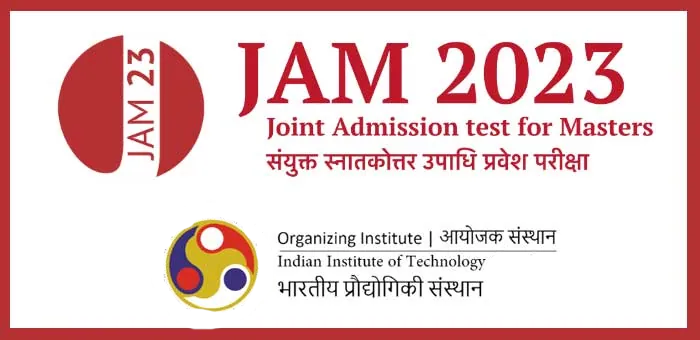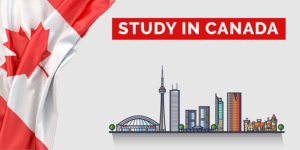
The Indian Institute of Technology Joint Admission Test (IIT–JAM) is an all–India competitive entrance examination conducted by the IITs for admission to integrated PhD degree programmes at IITs. The test is conducted in online mode and consists of multiple choice questions. The duration of the exam is three hours. The syllabus of the exam is based on the subjects of Physics, Chemistry and Mathematics.
Indian Institute of Technology–Joint Admission Test (IIT–JAM) Entrance Test
The IIT–JAM is an entrance examination for admission to integrated PhD programmes, MSc programmes, and other Post–Bachelor Degree Programmes at the Indian Institutes of Technology (IITs) and Indian Institute of Science (IISc). It is administered by the IITs on behalf of the Ministry of Human Resource Development (MHRD), Government of India. The exam is conducted in two phases, the first phase being an online test and the second phase being a physical examination. The first phase consists of multiple–choice questions on topics related to Mathematics, Physics, Chemistry, and Biology, while in the second phase the students are judged on their performance in the physical exam. The exam is conducted once every year, usually in the month of February/March.
Indian Institute of Technology–Joint Admission Test (IIT–JAM) Eligibility Criteria
In order to be eligible to appear for the Indian Institute of Technology Joint Admission Test (IIT–JAM), the following criteria must be met:
1. The candidate must have a Bachelor‘s degree in Science/Mathematics/Statistics/Computer Applications or equivalent with a minimum of 55% marks (50% for SC/ST/PwD).
2. Candidates in the final year of their Bachelor‘s degree can also apply.
3. The candidates must have taken at least one of the following qualifying examinations: * IIT–JEE * AIEEE * ICAR (for Agriculture and related disciplines)
* GATE
* CSIR–UGC NET
* NBHM
* JEST
4. The age limit for IIT–JAM is 26 years for General and 31 years for SC/ST/PwD categories.
5. A maximum of two attempts is allowed for IIT–JAM.
Indian Institute of Technology–Joint Admission Test (IIT–JAM) Colleges In India
• Indian Institute of Technology (IIT) Delhi
• Indian Institute of Technology (IIT) Bombay
• Indian Institute of Technology (IIT) Kanpur
• Indian Institute of Technology (IIT) Madras
• Indian Institute of Technology (IIT) Kharagpur
• Indian Institute of Technology (IIT) Roorkee
• Indian Institute of Technology (IIT) Guwahati
• Indian Institute of Technology (IIT) Hyderabad
• Indian Institute of Technology (IIT) Gandhinagar
• Indian Institute of Technology (IIT) Indore
• Indian Institute of Technology (IIT) Patna
• Indian Institute of Technology (IIT) Bhubaneswar
• Indian Institute of Technology (IIT) Ropar
• Indian Institute of Technology (IIT) Jodhpur
• Indian Institute of Technology (IIT) Varanasi
• Indian Institute of Technology (IIT) Palakkad
• Indian Institute of Technology (IIT) Tirupati
• Indian Institute of Technology (IIT) Goa
• Indian Institute of Technology (IIT) Bhilai
• Indian Institute of Technology (IIT) Dharwad
• Indian Institute of Technology (IIT) Jammu
Indian Institute of Technology–Joint Admission Test (IIT–JAM) List of Stream
The IIT–JAM entrance exam is conducted for admission to Integrated Ph.D. programmes at the Indian Institutes of Technology (IITs). The entrance exam is conducted in the following streams:
1. Physics
2. Chemistry
3. Mathematics
4. Biotechnology
5. Geology
6. Mathematical Statistics
7. Computer Application
Indian Institute of Technology–Joint Admission Test (IIT–JAM) Syllabus
The syllabus for the IIT–JAM exam is divided into seven sections. The topics covered in each section are as follows:
I. Mathematics
A. Algebra: Sets, relations, functions, algebra of sets, matrices, determinants, linear equations, vector spaces, group theory, rings, fields and Boolean algebra
B. Calculus: Limits, continuity, differentiation, integration, series and differential equations
C. Coordinate Geometry: Straight lines, circles, conic sections, three dimensional geometry
D. Statistics & Probability: Probability, random variables, probability distributions, sampling theory, estimation and testing of hypothesis
II. Physics
A. Mechanics: Kinematics, particle dynamics, rigid body dynamics, conservation laws, central force motion, harmonic motion
B. Electrodynamics: Electric & magnetic fields, electrostatics, current electricity, Maxwell’s equations, electromagnetic waves
C. Optics: Interference, diffraction, polarization, optical instruments
D. Thermodynamics & Statistical Mechanics: Laws of thermodynamics, thermal properties of matter, kinetic theory of gases
III. Chemistry
A. Physical Chemistry: Atomic structure, chemical bonding, states of matter, solutions, chemical & physical equilibria, electrochemistry, thermodynamics, chemical kinetics
B. Inorganic Chemistry: Periodic table, coordination compounds, nuclear chemistry
C. Organic Chemistry: Alkanes, alkenes, alkynes, aromatic compounds, stereochemistry, reaction mechanisms
IV. Biochemistry
A. Biomolecules: Structure, properties and functions of proteins, carbohydrates, lipids, nucleic acids
B. Enzymology: Kinetics and mechanism of enzyme–catalysed reactions
C. Metabolism: Glycolysis, Krebs cycle, oxidative phosphorylation
D. Molecular Biology: DNA replication & transcription, genetic code and protein synthesis
V. Geology
A. Structural Geology: Folds, faults, joints, unconformities, plate tectonics
B. Petrology: Igneous, sedimentary and metamorphic rocks
C. Mineralogy: Properties and classification of minerals
D. Stratigraphy: Stratigraphic column, biostratigraphy, stratigraphic correlation
VI. Computer Science
A. Programming Languages: C, C++, Java, Python
B. Operating Systems: Windows, Linux, Unix
C. Database Systems: SQL, Oracle, MS Access
D. Algorithms: Searching, sorting, graph theory
VII. Atmospheric Science
A. Atmospheric Dynamics: Pressure & temperature, winds, atmospheric circulation & fronts, storms
B. Cloud Physics: Structure & formation of clouds, precipitation processes
C. Atmospheric Chemistry & Pollution: Composition of atmosphere, air pollution & its control
D. Climate Change & Global Warming: Causes & effects of climate change, mitigation strategies



